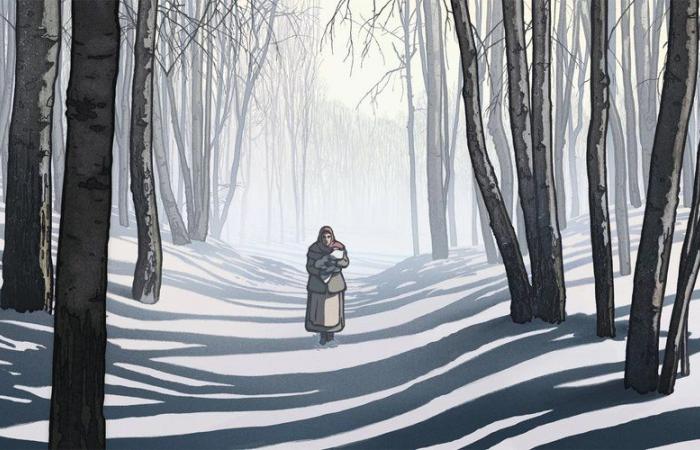With “The Most Precious of Commodities”, in theaters this Wednesday, November 20, the Oscar-winning director of “The Artist” Michel Hazanavicius, signs an animated tale about Polish Righteous people at the heart of the worst atrocity of the 20th century. Masterpiece.
“Once upon a time, in a big wood, there lived a poor woodcutter and a poor woodcutter.” The wonderful voice of Jean-Louis Trintignant, so overwhelmingly human, welcomes us, and picks us up, in the cold of the Polish winter which at that time was also that of humanity. He is the narrator of this unique animated tale that looks at the best at the heart of the worst.
Allegory of the “Heartless”
So, in a forest that we guess is Polish, during a world war that we know is second, Poor woodcutter and Poor woodcutter live on little, almost nothing, he having to lend his arms to the occupying forces, she looking for all the days enough to ensure their meager subsistence. And every day the woman implores “the train gods” of whom she knows nothing about the merchandise he carries daily, to leave him a little something. One day, she was granted: in the snow, she discovered an infant thrown by someone through the window of a sealed wagon.
She takes him in against the advice of Poor Woodcutter: he only sees another mouth, and what’s more, the mouth of the “heartless”, this race hated by all, who are not even said to be human. One day, however, he will listen to his heart, and hear that of the child, a girl he will make his own. But soon they will be confronted with ordinary hatred. But soon the absolute horror of the death camps…
Coming from a Jewish family of Lithuanian and Polish origin, Michel Hazanavicius promised himself never to make a film about the Shoah, considering the problem of its fictional representation to be insoluble. But that was before producer Patrick Sobelman and Studiocanal offered to adapt The Most Precious Commodity, at the suggestion of its author Jean-Claude Grumberg, who happened to be friends with his parents since they were teenagers. Of which act.
From figurative to abstract
The Oscar-winning filmmaker for The artistwho we discover is also a talented designer in his spare time, developed the design of his film himself. Semi-realistic, his thick, stylish line drawing with powerful contrasts, which is inspired by the first Disney, 19th century painting and the Japonism-tinged canvases of Henri Rivière, reveals a beauty of all the more shattering as it is without ostentation.
His production is similarly subtle, attentive, trusting as much in silence as in the off-camera. She knows the overwhelming power of suggestion when it slides from the most figurative (the daily life of these game heroes) to the most abstract (the extermination camps). She does not evade, she sketches it. And its mention breaks our hearts in a terrifying proliferation of screaming faces. From The Tomb of the Fireflies by Isao Takahata, no animated film had reached this level of sadness and sobriety to express the horror. Masterpiece.






